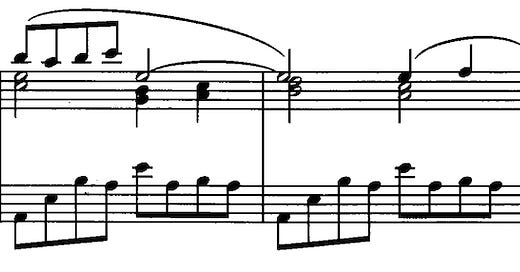More Piano Textures
Last week, I discussed how to expand simple harmony and melody into a more elaborate arrangement and this time we will explore this further, again using the main theme from Final Fantasy VII composed by Nobuo Uematsu.
Above was the complex of the two textures from the last time, however this will become the more simple version as we look to see how textures can always be expanded further.
As beautiful as the voicings in the first example are, they lack motion which is great if that’s what you want but when you want the piece to develop, motion is a great tool to be able to control, and arpeggios are a great way to achieve this. We can see that the harmony is the same, E major to C# minor but this time large arpeggios are played in the left hand across two octaves, creating motion and a warm, large supportive sound to the right hand.
The right hand has also been expanded by playing the melody in octaves whilst filling in the other notes in the chord in between. The choice of filler notes is interesting, since the melody begins with root note, it makes sense to play full E chord underneath but the second note is F# (2nd). Now, F# could be the root of a F# minor chord or the 5th of B or a few more things still, but that would distract the listener away from the sound of E major. So a B note is played which was heard previously as the 5th of the E and creates a nice thickening type sound without bringing much attention to itself or implying any other harmony.
In the next bar with the C# minor, there is a lovely cluster between the D# (9th) and the E (minor 3rd) which is resolved at the end of the bar. I have found this device in many piano works by Claude Debussy, Doctor Gradus ad Parnassum comes to mind.
Above is the answering phrase to the one at the top. I love the latter bar here with the large arpeggios in the left hand but especially the right hand with the melody in octaves the other voices being held. This can be quite tricky to play as the voices must be heard as independent and using the sustain pedal would muddy the sound too much and the detail would be lost. Although difficult, managing this many voices and more is part of what makes playing piano fun.
The bar above is a great example of the different voices swapping their roles. The left hand again is providing arpeggios to creating movement but the right hand has the real magic where at first the melody is on top with the lower voices underneath but when the top melody comes to a rest on beat 3, the lower voices come to life and ascend into the next bar creating a counter melody. A important tool for good melodies are often broken into phrases with pauses, sometimes out of necessity so a singer or wind player can breath but even when this is not the case, melodies in phrases are common. However, when the main melody pauses, the music cannot simply stop and although the left hand is still creating motion with the arpeggios, it leaves something to be desired, and then comes the countermelody to the rescue, giving the main voice a break and providing novel tones and an opportunity for some else to shine.
Warm Regards






